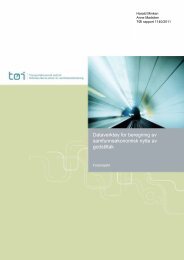Trafikkopplæring i Danmark 'fra vugge til rat' - Transportøkonomisk ...
Trafikkopplæring i Danmark 'fra vugge til rat' - Transportøkonomisk ...
Trafikkopplæring i Danmark 'fra vugge til rat' - Transportøkonomisk ...
Create successful ePaper yourself
Turn your PDF publications into a flip-book with our unique Google optimized e-Paper software.
Traffic education in Denmark: ‘From cradle to wheel’<br />
accidents the best estimate is a reduction in the number of accidents of 23 %,<br />
however not significant.<br />
Effects of restrictions in the number of passengers: The number of passengers increases the<br />
accident risk for young drivers. One study found a significant reduction in the<br />
number of accidents for the first 6 months after the introduction of a GDL-program<br />
which included passenger restrictions.<br />
Deviant driver behaviour and measures for behaviour change<br />
The chapter discusses deviant driver behaviour, its causes, and potential<br />
countermeasures to mitigate deviant driver behaviour. Relative risks of being<br />
involved in personal injury accidents for some types of behaviour, driver states and<br />
conditions as drink driving, drug and medicine abuse, age, speeding, personality traits<br />
and psychiatric diagnoses as potential causes of accidents, are presented.<br />
Personality traits can be defined as dimensions of individual differences regarding the<br />
tendency of displaying consistent patterns of thinking, emotions and behaviour. It is<br />
especially the trait of “sensation seeking” that has been associated with violations of<br />
traffic regulations, but also aggression, impulsivity, emotional instability and social<br />
deviance have been linked to violations of traffic law and regulations. Ulleberg<br />
identifies six sub-groups of drivers 18-22 years of age which differ significantly<br />
regarding the configuration of personality traits. Two of these groups stand out<br />
negatively by bypassing traffic law and regulations to a larger extent than the other<br />
sub-groups. They can behave relatively irresponsible and aggressively, they have low<br />
tolerance of frustrations, and they show low consideration and concern regarding<br />
others. Ulleberg labels these two groups socially deviant drivers and aggressive drivers.<br />
Both sub-groups have accident risks above average.<br />
It has been claimed that drivers with an ADHD-diagnose (Attention Deficit<br />
Hyperactivity Disorder) have a relative risk of being involved in an accident which is<br />
3-4 times higher than drivers without ADHD, but recent estimates from metaanalysis<br />
indicate that the relative risk may be as low as 1.24. Drivers who have ODD<br />
(Oppositional Defiant Disorder) and/or CD (Conduct Disorder) as comorbid states<br />
in addition to ADHD have, however, higher relative risks than ADHD-drivers<br />
without such comorbidity.<br />
American research, which have focused on so-called “problem drivers”, have<br />
evaluated measures that potentially can improve the accident risk by changing driver<br />
behaviour. The most efficient measures are defensive driving courses, warning letters<br />
of license suspension, and license revocation, measures that seem to reduce the<br />
number of accidents by 14 – 21 %.<br />
Ideas and strategies for improving research competence and -environments<br />
The purpose of the chapter is threefold:<br />
• Map existing research environments and competence on road safety for children<br />
and adolescents.<br />
• Indicate areas where more research and competence are needed.<br />
• Propose how research environments and competence on road safety for children<br />
and adolescents can be improved in Denmark.<br />
These issues have been addressed through studies of 80 publications from the last 10<br />
years in Danish professional journals, conferences and report series. In addition,<br />
VI Copyright © Institute of Transport Economics, 2012







